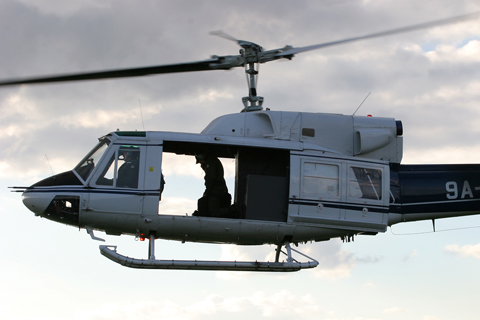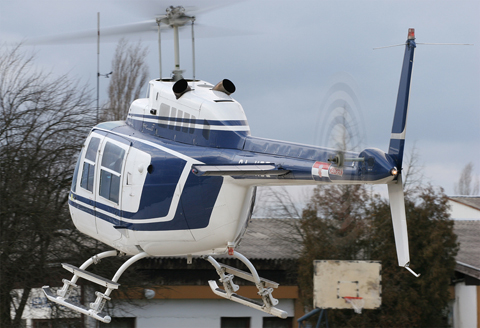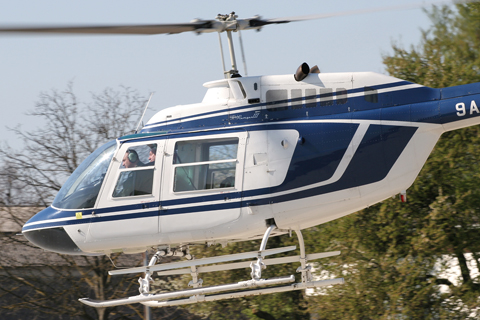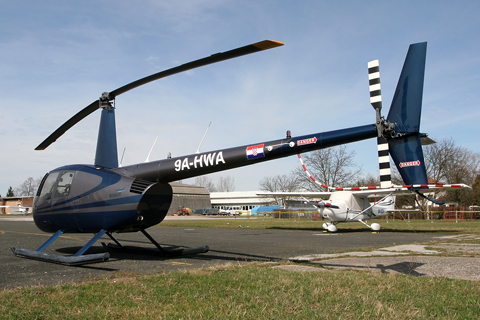By me
All photos me too, copyrighted
It has always been a tradition at smaller airfields in the region – the kind where everybody knows everybody – to stick around after your daily flying is done and spend some time exchanging stories, banter and aviation gossip with whomever might be there. For many, this has always been the perfect time to sit back and enjoy the beauty of light aviation to the fullest, free from the nagging needs of planning, weather, paperwork, finance and other elements that sometimes conspire to take the joy out of flying…
In my case though, this has always been the ideal opportunity to snoop around the airfield a bit, wander into hangars, peek into cockpits – and, naturally, attempt to snap an interesting photo or two 😀 . A method that had served me well in compiling most of the material previously featured here, it had come through once again on 30 September, providing an effective cure for my recent photographic dry spell – the beautiful Sud Alouette II 9A-HAT, nowadays the oldest helicopter in Croatia… 🙂

Approaching one of Lučko’s eastern aprons as Scheibe Falke 9A-DBV shoots some touch & goes in the back. I’d been chatting with a friend and enjoying the sunset when I heard an unfamiliar rotor/engine combination… a quick sprint with my camera across the field had revealed that an already fine flying day was about to get much better!
The cat in the HAT
One of the most groundbreaking designs to have been borne by the French helicopter industry – despite looking like it had been cobbled together in a shed – the SE-3130 Alouette II can trace its roots back to the early 50s and the lessons learned with the similarly named (but mechanically only distantly related) SNCASE* SE-3120 Alouette of 1951. An open framework two-seater powered by a homegrown 200 HP piston engine, the Alouette was in essence the first properly usable French helicopter, combining a light, but strong airframe, good performance – and, for the first time, less than harrowing handling characteristics 🙂 . However, while it did well up in the air (even capturing the closed-circuit distance record for helicopters at 1,250 km / 675 NM), it was a nightmare to maintain and service, resulting in a rather limited production run of just two prototypes…
* apart from its long history of innovation, the French aviation industry is also known for its rather complicated family trees. The original Alouette was, as noted, produced by SNCASE, short for “Société Nationale de Constructions Aéronautiques du Sud-Est”, or “The National Society for Aeronautical Constructions of the South-East (of France)”. Mercifully, by the time the Alouette II went into production, this was shortened to the much more agreeable Sud Aviation. However, during the massive industry consolidation of 1970, Sud became part of a new, powerful conglomerate called Aerospatiale, which would pretty much dominate the continent’s helicopter industry until its 1999 merger with German equivalent MBB to form Eurocopter. Having been under the auspices of Airbus since its early days, this famous name would in early 2014 also head for the history books, to be replaced by the slightly sterile and bland Airbus Helicopters. Thankfully though, the Alouette II itself was spared much rechristening, having only ever been known under two names, the SE-3130 prior to 1967, and SA-313B after.
But, the Alouette’s demonstrated strengths were enough for the bright men of (now) Sud to keep beavering away at the design in an attempt to make it more appealing to both civilian and military customers. Well aware that the complexity and weight of the piston engine – not to mention its associated clutch – was the source of most of their troubles, the program’s chief engineer, Charles Marchetti, had soon decided that the only way forward was to go with the newly available turboprop engine. Even though this was still 1954, the idea was not really new in itself; helicopter visionary Charles Kaman had already gone down this road back in 1951, equipping one of his K-225 intermeshing rotor machines with a Boeing 502-2 turboshaft engine** developing 175 HP, thus creating the world’s first proper¹ turbine-powered helicopter.
** Kaman, being the genius that he was, would three years later also create the world’s first twin-engine turbine helicopter, swapping the R-1340 nine-cylinder radial of the HTK-1 (later to become the HH-43 Huskie) for two of the same 502-2s…
However, while the modified K-225 did manage to fly successfully – achieving a dramatic performance increase despite a 45 HP deficit over its previous 220 HP O-435 piston engine – it was still a very far cry from even a remotely operational turbine helicopter. Reports indicated that the engine, when used in a helicopter installation, was quite prone to compressor surge and power loss, rendering the single-engine K-225 pretty much unusable for any real-world application. The root cause was, understandably, the “early days syndrome”, brought on by the technology’s lack of maturity and parallel use in a novel application. Since there really were no physical barriers to the idea working, getting an operational helicopter onto the shelves had quickly turned into a simple race at who’d iron out all the bugs first 🙂 .
HATs off!
As 1955 had dawned, Sud was edging ever so closer to claiming the trophy. Its partnership with another French institution – the engine maker Turbomeca – had produced quite the positive result, with one of the company’s Artouste II turboshafts already being mated to the new SE-3130 Alouette II. A clean sheet design only vaguely based on the configuration of the original Alouette, the II still fell some distance short of the model we know today, sporting a cabin for only two (the rest of the space being occupied by the fuel tank) and commanding a modest 450 thermodynamic HP, de-rated in normal operations to just 350.
Flying for the first time on 12 March the same year, the prototype would soon begin to evolve towards a definitive production standard, gaining an elongated cabin seating five, a larger fuel tank located directly below the engine for an improved center of gravity – and a more powerful Artouste IIc engine developing 530 HP on full beans and 460 de-rated. In this guise, it would enter production in April 1956 – nearly three years ahead of the runner-up, the Bell XH-40, which would enter service in 1959 as the legendary UH-1 – thus winning the title of the world’s first series-produced turbine helicopter 🙂 .
However, the Alouette II’s list of firsts did not end there. The lesser of the rest was the distinction of being the first helicopter type to carry munitions, specifically the Nord SS.11s wire-guided anti-tank missile; however, the big one was the lead role in the first recognized helicopter air rescue, when test pilots Jean Boulet and Henri Petit airlifted a heart attack victim from the Valliot refuge on the slopes of Mont Blanc on 3 July 1956, flying in at an altitude of 4,362 meters / 14,311 ft – just 448 m / 1,470 ft shy of the top of Europe. A similar feat was again repeated on 3 January 1957, when two Alouette IIs rescued the entire crew of a downed Sikorsky S-58 searching for young mountaineers Jean Vincendon and François Henry (who had sadly perished after 10 days on the snow).
The magic HAT
9A-HAT’s life on the other hand was decidedly less heroic, even though it did get the chance to see a fair bit of Europe! An original Alouette II of the same make and breed as the early production examples outlined above, HAT was completed in 1963 with the serial 1841/475C. Intended outright for military service, it had briefly carried the test reg F-WJDD (reused on several machines during acceptance test), before passing to the Heersflieger – German Army Aviation – as PO139. Throughout its service in Germany it appears to have changed several squadrons and identities, including PY211 and 7696. Following the type’s withdrawal from German service, it was sold on to Portugal, where it continued flying with the Guardia Nacional Republicana – the country’s gendarmerie – as 9208.
Leaving the military for good in 1993, it was then taken up by French operator Héli-Loc as F-GNEA, where it flew unspecified missions on behalf of the country’s electrical power and gas administration until its sale to operator Aéro 34 in 1997. The dawn of the 21st century would see it transferred to operator Avia-Flap in Italy under the reg I-DLSP, from where it would pass to its current home in 2002 🙂 . Flying since that time for operator Eudora Let (based in the popular coastal town of Vodice), HAT is listed on the company’s Air Operator Certificate (AOC) as being used for air work and utility duties – including aerial photography and cinematography, roles which had on 30 September brought it to Lučko… 🙂
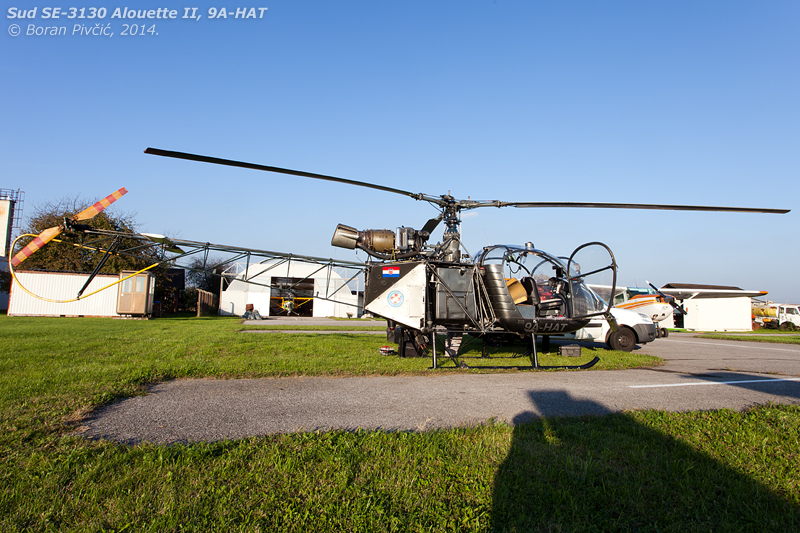
Cooling slowly down as it prepares for an overnight stop following an extended mission across the north of Croatia. A beautiful example of simple and straightforward design, the Alouette II is essentially made up only of a rudimentary cabin, a large fuel tank, some girders for the tail – and a compact, but very loud, Artouste bolted to its back…

Equally as simple as the exterior, the interior of HAT contains everything you really need for classic “day VFR” operations. The panel itself is a mix of instruments with German, French and English labels, a reflection of the colorful life it had led prior to its arrival to Croatia…

Quite a compact little package, the Artouste (in its original “Artouste I” version) was originally designed to serve as an Auxiliary Power Unit (APU) on larger aircraft – a role it ended up fulfilling only on the Vickers VC10. Realizing the sales potential of a light, low-power turboprop to power the next generation of light aircraft, Turbomeca squeezed more power out of it, added more sophisticated controls and renamed it the Artouste II…

A rare archive shot from the days HAT had still sported its original red-black scheme. Quality’s not the best, but at this point my first DSLR was still a year or so in the future…
I would also like to extend my sincere thanks to the owner (Mr. Zoran Matić) for allowing me to snoop around for a good half hour!
A bonus story:
¹ in reality, the first application – of any sort – of a gas turbine engine to a helicopter predates the K-225 by a few months, tracing its roots to the workshops of Sud’s sister company SNCASO (“Société Nationale de Constructions Aéronautiques du Sud-Ouest”, “The National Society for Aeronautical Constructions of the South-West (of France)”). As early as 1946, the company’s engineers had been working on designs using so called “jet blades”, blades with outlets at their tips through which compressed air (provided by the engine) would be blown at high speed, creating a propelling reaction in the same way as a jet engine – and thus turning the entire rotor without the need for a heavy and complicated transmission system. The company’s first two models – the SO-1100 Ariel I and SO-1110 Ariel II – were powered by piston engines, a particularly unsuitable type of powerplant given the need to power a big, heavy compressor that is not native to the engine. When the Turbomeca Artouste I prototype appeared in 1951, the company quickly seized the opportunity and stuck it into the Ariel II, creating the SO-1120 Ariel III. But while the gas turbine’s large mass flow did wonders for performance, the whole setup was still far too thirsty and inefficient compared to a traditional configuration, leading SNCASO to pull the plug on the Ariel family and focus on turning the III into an autogyro, the SO-1310…
Sources:
- Airbus Helicopters – SA-3130 history & SO-1120 history
- Smithsonian Air and Space Museum – K-225 entry
- Alouette & Lama Website – photos and 9A-HAT history
- Eurocopter – History 1953-1956









